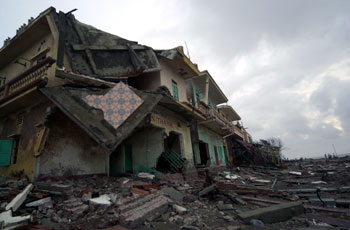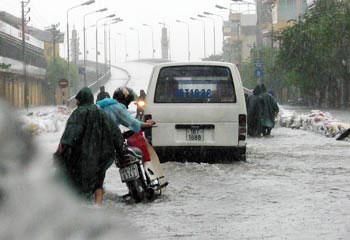Tiempo Climate Cyberlibrary
Disaster Reduction Measures for Typhoons and Floods
- Tiempo archive
- Complete issues
- Selected articles
- Cartoons
- Climate treaty
- Latest news
- Secretariat
- National reports
- IPCC
About the Cyberlibrary
The Tiempo Climate Cyberlibrary was developed by Mick Kelly and Sarah Granich on behalf of the Stockholm Environment Institute and the International Institute for Environment and Development, with sponsorship from the Swedish International Development Cooperation Agency.
While every effort is made to ensure that information on this site, and on other sites that are referenced here, is accurate, no liability for loss or damage resulting from use of this information can be accepted.
 |
James Lewis discusses the need for a comprehensive approach to limiting typhoon and flood impacts in Vietnam and elsewhere. |
| The author is a researcher and writer on natural hazards, construction and development. He has worked as a consultant in Bangladesh, Africa and island states in the South Pacific and the Caribbean. | |
Reports from Vietnam of Typhoon Lekima, which in October 2007 displaced populations for the second time in a year and killed at least 77 people, are another reminder that Vietnam is a country seriously affected by typhoons and floods. The central region of Vietnam has experienced five major floods since August. How best can the already high incidence of flooding, forecast to increase, be most effectively countered?
Vietnam and Bangladesh are the two continental countries having the largest percentages of their populations living within the global low-elevation coastal zone (see Tiempo, Issue 59, April 2006), that of Vietnam being the higher at 53 per cent. Of a national total of about 83 million, therefore, 44 million Vietnamese people are exposed to sea-level rise and its associated hazards, in heavily-populated coastal lowlands and delta regions.
Vietnam forms the eastward extent of the Indochinese peninsular. Its borders with China, Laos and Cambodia total 3,000 kilometres, "a very long border compared to the country's surface area," notes geographer Vu Tu Lap, matched by its coastline to the east of 3,444 kilometres. This creates a low-elevation coastal region of considerable length, exposed to the South China (or Eastern) Sea.
Central Vietnam is only 50 to 100 kilometres wide, with approximately 500 kilometres of coast directly exposed to the sea. Exposure to the sea is disproportionately high to land area: "It is on the shores of central Vietnam's flat coastal alluvial plains that the waves break highest and are most numerous," according to Vu Tu Lap.
On a coastline repeatedly inset by estuaries, coves, backwaters and lagoons of up to 70 kilometres in length, inflow of the sea is tempered by a system of dykes, dams and lakes to regularize the flow of sea water and to counteract stagnation in the dry season.
Centred on the UNESCO World Cultural Heritage Site of Hué City, on the Huong (Perfume) River, and itself centrally located on Vietnam's Green Corridor and complex coastline, Thua Thien Hué Province has an overall area of 5,000 square kilometres, a population of 1.3 million, an average population density of 225 per square kilometre and direct exposure to the sea. The population of this province has increased by 12.25 per cent since 1995, only marginally less than Vietnam's national population growth during the same period.
Thua Thien Hué province is one of three contiguous coastal provinces in which together, from 1980 to 2006, almost 2,000 people having been killed by windstorms, typhoons and floods (figures from the Emergency Events Database, EM-DAT). Sixty per cent of this total, and 84 per cent of the number of people made homeless, have resulted from typhoons and windstorms. For the whole of Vietnam, from 1975 to 2001, the same source records 13,275 deaths from typhoons, windstorms, floods and droughts.
In recent years, attention has turned to the disproportionate exposure and loss of the extended coastal region of Vietnam. Building on earlier experience in Vietnam with the United Nations Centre for Human Settlement (UN-Habitat), Development Workshop France (DWF) has, since 1999, promoted the preventive strengthening of existing houses in Central Vietnam. This work was undertaken with initial support from the Canadian International Development Agency and, since 2003, from the European Commission Directorate for Humanitarian Aid.
Preventive strengthening is based on the rapid training of artisans and community leaders in the application of ten key generic principles of typhoon and flood resistant domestic design and construction. DWF also promotes awareness-raising events in schools and in public places using media ranging from theatre to boat races and traditional community communication methods by television, to get across the message that prevention is easy, cheap and durable. Although every house has different needs, the average cost of strengthening is about 25 per cent of the house value. Access to credit and financial encouragement is part of the package.
 |
Impact of
Typhoon Damrey, September 2005, Vietnam
© Luong Quang Huy |
In 1999, DWF reported that community leaders thought the idea of strengthening houses was laughable. Then, in October 2006, the hundreds of buildings that had been strengthened under the DWF programme withstood the impact of Typhoon Xangsane that destroyed 20,000 other houses and unroofed 250,000 more in the three central provinces. The provincial authorities issued an edict throughout the population, stating that the DWF ten key principles had to be applied to houses and public buildings to avoid further damage from future disasters. Community leaders and families alike are now convinced that investing in prevention is cheaper than waiting for a storm to come and paying the high price of reconstruction.
This kind of programme is well justified as one small but significant measure against recurrent losses, together with other initiatives such as those by the International Federation of Red Cross and Red Crescent Societies. But, in current and forthcoming contexts of climate change and rising sea levels, deaths, homelessness and economic losses are set to continue, and to increase overall. Reports from Reuters suggest a further 58,000 houses, north of the central region, were damaged or destroyed by the 130 kilometre per hour winds of Typhoon Lekima, with estimated damages of US$130 million. Losses will increase inexorably where there has been little preventive strategy. Indications are that repetitive and costly post-disaster assistance might not continue to be available from international sources.
 |
Impact of
Typhoon Damrey, September 2005, Vietnam
© Luong Quang Huy |
Typhoons and floods do not select, they are random in their strengths, incidence and impacts. Housing and its occupants are not the only victims; workshops, docksides, fishing fleets, farms and agriculture all need simultaneous protection. Now, tried and tested as individual long-running projects, in Vietnam and elsewhere, an overall developmental concept could bring together successful initiatives through multidisciplinary participation against typhoons and floods within a single framework. This framework should include reconstruction, construction and maintenance of dykes for flood resistance and water control, mangrove plantations and other vegetation for wave reduction and dune stabilization, cyclone shelters and killas (raised platforms) for population and animal security, communications systems for promulgation of warnings as well as construction-strengthening projects. These could all be a part of the same development programme.
Why is it that such programmes are in such short supply ? Climate change and sea-level rise were recognized during the 1980s, 15 years after research into vulnerability reduction had become established, and should have heralded then the need for its application. If only on grounds of cost-effectiveness, concerted developmental strategies towards vulnerability reduction and resilience enhancement would show immediate benefits. And lives would be saved, houses and other buildings would remain intact, populations would not be displaced, direct and secondary economic losses would diminish, and quality of life would be raised.
But pre-disaster has never held the initiative nor the resources. Post-disaster, after people have been killed and dwellings destroyed, is more dramatic, attracts greater publicity - and, therefore, more kudos and more money. It is also so much more cruel.
Eminently successful and praiseworthy projects, such as domestic construction strengthening in central Vietnam, with future typhoons and floods in mind, show the way and demonstrate the success that professional rigour and popular participation can generate when given the opportunity. It is time for a comprehensive perspective.
Further information
James Lewis, 101 High Street, Marshfield, Chippenham, Wiltshire SN14 8LT, United Kingdom. Email: datum@gn.apc.org. Web: www.livingwithflooding.eu.
On the Web
Further information about the work of DWF in Vietnam and background information on the threat of typhoon and flood impacts is available on the DWF website.
Bright Ideas

General Electric plans to cut solar installation costs by half

Project 90 by 2030 supports South African school children and managers reduce their carbon footprint through its Club programme

Bath & North East Somerset Council in the United Kingdom has installed smart LED carriageway lighting that automatically adjusts to light and traffic levels

The United States National Oceanic and Atmospheric Administration and the American Public Gardens Association are mounting an educational exhibit at Longwood Gardens showing the link between temperature and planting zones

The energy-efficient Crowne Plaza Copenhagen Towers hotel is powered by renewable and sustainable sources, including integrated solar photovoltaics and guest-powered bicycles
El Hierro, one of the Canary Islands, plans to generate 80 per cent of its energy from renewable sources

The green roof on the Remarkables Primary School in New Zealand reduces stormwater runoff, provides insulation and doubles as an outdoor classroom

The Weather Info for All project aims to roll out up to five thousand automatic weather observation stations throughout Africa

SolSource turns its own waste heat into electricity or stores it in thermal fabrics, harnessing the sun's energy for cooking and electricity for low-income families

The Wave House uses vegetation for its architectural and environmental qualities, and especially in terms of thermal insulation

The Mbale compost-processing plant in Uganda produces cheaper fertilizer and reduces greenhouse gas emissions

At Casa Grande, Frito-Lay has reduced energy consumption by nearly a fifth since 2006 by, amongst other things, installing a heat recovery system to preheat cooking oil
Updated: May 15th 2015